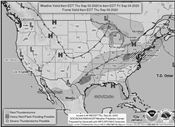|
With Laura Past, Arkansas Growers Still Bogged By Week Of Rain
LITTLE ROCK, ARK.
Although Arkansas growers by and large escaped the worst of Tropical Storm Laura’s destruction, the days of rain that followed have halted the burgeoning 2020 harvest in its tracks.
The storm, which was briefly upgraded by the National Weather Service to a Category 4 hurricane as it came ashore in Louisiana on Aug. 27, then downgraded later the same day, brought as much as 10 inches of rain to some areas of Arkansas, and winds as high as 50 mph.
Waves of storms since Laura have set rainfall records for the month of August in southwestern Arkansas, including new state record at Big Fork in Polk County which saw 19.70 inches of precipitation, according to the National Weather Service.
While some counties in the southwestern part of the state saw limited structural damage, growers in most areas of the state reported some degree of crop damage. The most common complaint was saturated fields and scattered instances of lodging in corn, rice and soybeans.
The days that have followed, however, have allowed little to no sunshine to dry those areas and several inches of rain have continued to saturate most of the state. According to a weekly crop progress report from the U.S. Department of Agriculture, about 14 percent of the state’s corn crop had been harvested as of Aug. 30 – less than half of the five-year average for this point in the season.
Jason Kelley, extension wheat and feed grains agronomist for the University of Arkansas System Division of Agriculture, said most operations had come to a halt as of this week.
“There’s not too much happening,” Kelley said. “We’re waiting for some sunshine and dry weather. Heard one combine was running in south Arkansas yesterday, but it doesn’t look like any harvest today for the north half of the state and likely not much in the south, either. We need some dry weather!”
Rice harvest has also stalled, with 5 percent of the state’s crop harvested as of Aug. 30 – about a third of the five-year average, according to USDA.
Jarrod Hardke, extension rice agronomist for the Division of Agriculture, said that while Laura did direct damage to a relatively small percentage of Arkansas rice acreage, greater economic impact is likely to stem from the ongoing delays.
“The issue is larger than just the 5 percent of acreage that was actually damaged in the storm, as subsequent rain and wind in the days since have only increased lodging in the fields,” Hardke said.
“The longer it takes for the ground to dry out, the longer harvest will take,” he said. “The thing to remember is that the crops that were ready for harvest a week ago are now a week overdue. The longer a crop that’s ready for harvest sits in a field, the higher potential you have for loss of quality, and declining yield potential.”
As of Thursday morning, the National Weather Service was forecasting heavy rains throughout the entire state through Friday. ∆

Although Arkansas growers by and large escaped the worst of Tropical Storm Laura’s destruction, the days of rain that
followed have halted the burgeoning 2020 harvest in its tracks.
Image courtesy National Weather Service
|
|